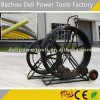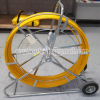Introduce
TRACEABLE DUCT RODDER containing metal lines, can be used to detect equipment easily detect the direction of the pipeline, as well as the location of the TRACEABLE DUCT RODDER .
We can generate the TRACEABLE DUCT RODDER has two kinds, one is to be able to carry the monitoring function, one kind is the individual tracking function. The difference between the two is that with a probe into the function of a video wire inside, and a power cable, you can head the head to install the head, in order to view the situation in the pipeline. A bare copper wire can be used to locate and track the position of the TRACEABLE DUCT RODDER in a single probe function.
The traceable duct rodders are available in 8mm-16mm diameter. Detectable duct rods are used to find, follow and accuratelymap the duct route without digging or trenching. The traceable duct rod is used in conjunction with both a signal transmitter and a receiver. The easily identifiable signal is transmitted along the entire length of the duct rod.
The traceable duct rod has an 18 AWG copper wire, almost twice the size of the competition, in the center of the fiberglass core. The copper wire is also connected to the end fittings so the transmitter leads canmake a direct connection to the copper wire. The female end fitting provides the attachment point for the transmitter's lead connection. The other transmitter lead is connected to a stake driven into the earth. The direct connection of the signal to the copper wire provides themost effectivemethod of signal transmission.
Roddiameter:φ6mm,φ8mm,φ9mm,φ10mm,φ11mm,φ12mm,φ13mm,φ14mm,φ15mm,φ16mm.Rod length:80m,100m,120m,150m,200m,250m,300m,350m,400m,500m.
Product application
360 rotary pipe video detector, large pipe endoscope, can detect 200mm to 1000mm pipeline.
With a metal detector on the ground, can detect the direction of pipeline laying, fault point and location of pipeline. The application of non excavation construction is very extensive.
Product classification
The frames
Rod selectIon
Which is the right rod diameter for any given application? The rod selection is usually governed by several factors including:
The size of ducting it is to be pushed through
The distance the rod is to be pushed
The number and tightness of bends in the ducting
If the ducting is already occupied by cable
When being pushed through the duct, any rod will tend to form "sine waves", hitting the wall of the duct at certain intervals.
Each time the rod comes in contact with the wall of the duct, it causes friction. The friction will build and eventually prevent the rod from being pushed any further. Small rod in large duct will make more frequent contact with the ducting; the same rod in smaller duct will make less frequent contact and therefore less friction so it can be pushed further. Large rod in small ducting is a good situation, but reduced flexibility of the rod may cause increased friction in the tighter bends.
Meter mark
Manufacturing workshop
Product display




















